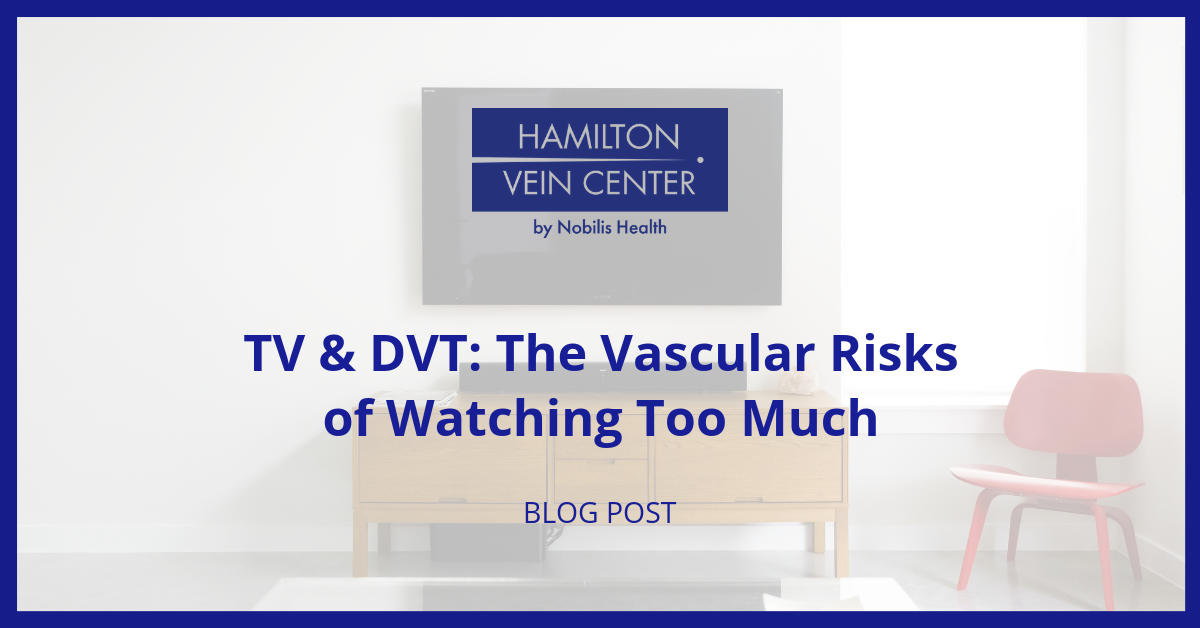TV & DVT: The Vascular Risks of Watching Too Much

All American Pastime
Though other activities such as gaming or browsing the internet have started to chip away at it, there’s no doubt that watching TV is the most popular American pastime. In 2017, the average person spent 238 minutes a day—about four hours—vegging out in front of the tube. [1] But as fun as it is watching a much-loved sitcom, drama, reality show, or sport, this has some serious consequences on health.
Among the symptoms that can be affected is your circulation, as was highlighted in a recent study that linked excessive TV watching with deep vein thrombosis (DVT) and related disorders. [2] This condition, characterized by clots in deeper veins in the leg, is painful, uncomfortable, and potentially very dangerous. Let’s get to the bottom of this research.
A Look at the Folks at Home
To assess the relationship between sedentary lifestyle and vein conditions, Dr. Mary Cushman and her colleagues at the University of Vermont, relied on data from the Atherosclerosis Risk in Communities Study. In all, they looked at 15,158 people aged 45 to 64 who did not have DVT or related conditions between 1987 and 1989. [2] These participants were asked to rate their viewing habits from “never or seldom” to “very often.” The team followed up and looked to see if cases of DVT cropped up in them between 1993 and 1995, and between 2009 and 2011.
Prime Time Numbers
Adding together the total number of years assessed in this population, the researchers found they had 299,767 “person-years.” During that time, they found 691 cases of DVT or related types of blood clots. After statistical analysis, it was determined that TV viewing had a “dose-response” effect: the more that was watched, the higher the likelihood of developing these conditions. Among participants who rated their viewing as “very often,” the likelihood of developing DVT was 1.7 times higher. [2]
Associated with all this was the fact that rates of obesity were also higher in populations that were spending more time in front of the TV. This is in keeping with other work that points to the danger of sitting uninterrupted for long periods of time. Notably, there was still an effect even for those who regularly worked out; rates of developing DVT or other clotting issues were still the same for the “very often” viewing group. [2] Limiting such periods of inactivity will definitely help.
Getting Off the Couch
So what can you do to manage this risk, especially if you just have to watch the next episode of American Idol or Game of Thrones? Dr. Cushman had a couple ideas, telling Medical News Today: “You could put a treadmill or stationary bike in front of your TV and move while watching.” [2] Just imagine the benefits of spending some of that daily four hours getting exercise; you’ll be killing two birds with one stone!
Making sure you’re not watching too much TV, or sitting too much in general, has a wide range of positive effects; it helps combat obesity, heart disease, and many other conditions. Indeed, trying to take on sitting too much—whether at work or at home—is a major priority of the American Heart Association. In a statement released in 2016, their board noted that sedentary lifestyle is “associated with all-cause and cardiovascular morbidity and mortality,” and urged more response to this issue from the public health community. [3]
Changing the Channel
Especially if you suffer from vein diseases, it’s time to change the channel. It can’t hurt to set limits on how much you’re watching—perhaps by programming a reminder in your smartphone—hard as that may be when, let’s face it, there’s a lot of great television on. Perhaps it’s time to get that treadmill or stationary bike after all, as that way you can keep up with your shows and your exercise. Doing something is going to be better than doing nothing. And when it comes to cardiovascular health, every little bit helps.
If you suffer from DVT, varicose veins, or any other venous or arterial disorder, the team at Hamilton Vein & Vascular can help. The experts at these Texas-based outpatient clinics employ the latest and best in techniques and technologies to ensure positive outcomes for their patients. Find out more about what they do by calling the Houston office at (281) 565-0033, Austin’s clinic at (512) 710-1114, or San Antonio at (210) 405-4707 today!
References
- “U.S. Media Usage – Time Spent Watching Television 2020 | Statistic”. 2018. Statista. Accessed October 19 2018. https://www.statista.com/statistics/186833/average-television-use-per-person-in-the-us-since-2002/.
- Paddock, Catharine. 2017. “More TV Viewing Linked To Higher Risk Of Blood Clots In Veins”. Medical News Today. Accessed October 19 2018. https://www.medicalnewstoday.com/articles/320046.php.
- Young, D. R., Hivert, M, Alhassan, S, Camhi, S. M., Ferguson, J. F., Katzmarzyk, P. T., Lewis, C. E., Owen, N., Perry, C. K., Siddique, J., and Yong, C. M.. “Sedentary Behavior And Cardiovascular Morbidity And Mortality: A Science Advisory From The American Heart Association | Circulation”. 2018. Circulation. https://www.ahajournals.org/doi/abs/10.1